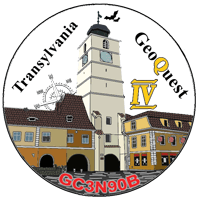Sibiu

The city of Sibiu, which is located in the center of Romania, is the seat of Sibiu county, with a population of 155.000 inhabitants. It numbers among the most beloved cities in Transylvania, due to its richi history.
The first documentary mentioning of the Sibiu area dates back from the year 1191, when the name Cibinium was written in a Vatican document. Starting with the year 1223, the citadel is also known by the name Hermannstadt, given by the German settlers to the area that soon became one of their most important headquarters.
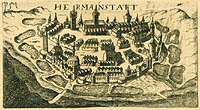 The
city was fortified by the end of the 12th century, but it did not withstand
the attack of the Tatars opposing the Hungarian armies. The citadel
was walled again in the following decades and had several defence walls,
with twelve towers guarding it(two of which can still be seen today).
The city developed further and soon became the strongest and safest
citadel in Transylvania, worth of the designation a bastion of Christendom
by Pope Eugene IV.
The
city was fortified by the end of the 12th century, but it did not withstand
the attack of the Tatars opposing the Hungarian armies. The citadel
was walled again in the following decades and had several defence walls,
with twelve towers guarding it(two of which can still be seen today).
The city developed further and soon became the strongest and safest
citadel in Transylvania, worth of the designation a bastion of Christendom
by Pope Eugene IV.
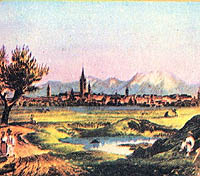 In
the 14th century, it became an important trade center, with craftsmen
divided into 19 guilds. It was officially stated a city in 1366. The
year 1544 marks the genesis of the first book printed in the Romanian
language, the Lutheran Catechism, written with Cyrillic letters. After
Transylvania formally became a part of the Habsburg Empire, the importance
of the city grew as it became the capital of the principality. The Habsburg
domination brought different and modern influences, especially regarding
architecture. New districts were built outside the fortress walls and
succesively the image of an old medieval fortress was replaced by that
of a modern city, with Viennese baroque edifices. The two most representative
buildings can be visited today: the Roman-Catholic Church and the Brukenthal
Palace (the latter being the most famous baroque monument in Sibiu).
In
the 14th century, it became an important trade center, with craftsmen
divided into 19 guilds. It was officially stated a city in 1366. The
year 1544 marks the genesis of the first book printed in the Romanian
language, the Lutheran Catechism, written with Cyrillic letters. After
Transylvania formally became a part of the Habsburg Empire, the importance
of the city grew as it became the capital of the principality. The Habsburg
domination brought different and modern influences, especially regarding
architecture. New districts were built outside the fortress walls and
succesively the image of an old medieval fortress was replaced by that
of a modern city, with Viennese baroque edifices. The two most representative
buildings can be visited today: the Roman-Catholic Church and the Brukenthal
Palace (the latter being the most famous baroque monument in Sibiu).
 Towards
the middle of the 19th century, Sibiu grew up to be a valorous national,
political and cultural centre for Romanians and their struggle to define
national consciousness. ASTRA (Transylvanian Association for Romanian
Literature and Romanians People Culture) had its headquarters in the
city, and so did the Romanian Permanent National Comittee, led by bishop
Andrei Saguna. Sibiu was the core of the Romanian resistance against
Austro-Hungarian domination, a place of cultural and political emancipation.
Simion Barnutiu composed the manifest-declaration and in 1863 The Transylvanian
Diet came into existance and later passed the act that demanded equality
of Romanians and other nations. Tensions between nations grew as the
Austro-Hungarian`s policy making wronged the Romanians. In 1884 came
the order to change the city name to Nagyszeben and, despite population
hostility, it was adopted starting with 1900. The nationalist movement
reached its peak in the second half of the 20th century, when The Romanian
National Party in Transylvania initiated The Memorandum Movement, known
as one of the most important national actions, that brought the Romanian
problems in Europe`s attention.
Towards
the middle of the 19th century, Sibiu grew up to be a valorous national,
political and cultural centre for Romanians and their struggle to define
national consciousness. ASTRA (Transylvanian Association for Romanian
Literature and Romanians People Culture) had its headquarters in the
city, and so did the Romanian Permanent National Comittee, led by bishop
Andrei Saguna. Sibiu was the core of the Romanian resistance against
Austro-Hungarian domination, a place of cultural and political emancipation.
Simion Barnutiu composed the manifest-declaration and in 1863 The Transylvanian
Diet came into existance and later passed the act that demanded equality
of Romanians and other nations. Tensions between nations grew as the
Austro-Hungarian`s policy making wronged the Romanians. In 1884 came
the order to change the city name to Nagyszeben and, despite population
hostility, it was adopted starting with 1900. The nationalist movement
reached its peak in the second half of the 20th century, when The Romanian
National Party in Transylvania initiated The Memorandum Movement, known
as one of the most important national actions, that brought the Romanian
problems in Europe`s attention.
Official acknowledgement of the city as part of Romania came at the end of the First World War, when Transylvania was united with Romania. The name of the city was officially changed to Sibiu starting with 1919, which is also the moment when streets were renamed with Romanian names. A noticeable thing is the tendency of conserving the old fortress, especially in the Lower City.
The Second World War brought semnificative changes in the population structure. Many Saxons were moved to different territories of the Third Reich and others volunteered in the German army. After the war ended, Saxons were deported to the URSS and during the communist regime 2800 persons were deported to Siberia.
During communism the city was not affected by drastic changes and 1968 it became seat of the county. In 1989 Sibiu was the second city to join the Revolution against the regime and suffered significant human and material losses. Clearance of past restraints led to the emigration of a great part of the Saxons to Germany, which determined a major lessening of this population in the area.
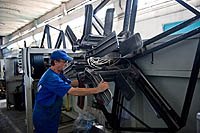 During
the last decades the city encountered a great economic and cultural
rebirth. Today it counts among the cities with the highest level of
foreign investments in Romania. Important names of the European industry
can be found in the West Industrial Area. Classical industries in the
city are engine work (Bilstein Compa), the garment industry (Mondex,
Mondostar), food supply industry (Scandia) and requisites industry (Flaro).
New factories were recently opened: electrical and electronical components
factories (Continental, Kuhnke Relee, Haartmann), bearing factory (SNR
Rulmen?i), airbags factory (Takata Petri) and driving belts factory
(investments of the German company Siemens). One of the advantages of
the city is the new beltway, which was initiated on the 1st of December
2010. It was built to reach highways standards and it undertook the
heavy traffic of East Europe.
During
the last decades the city encountered a great economic and cultural
rebirth. Today it counts among the cities with the highest level of
foreign investments in Romania. Important names of the European industry
can be found in the West Industrial Area. Classical industries in the
city are engine work (Bilstein Compa), the garment industry (Mondex,
Mondostar), food supply industry (Scandia) and requisites industry (Flaro).
New factories were recently opened: electrical and electronical components
factories (Continental, Kuhnke Relee, Haartmann), bearing factory (SNR
Rulmen?i), airbags factory (Takata Petri) and driving belts factory
(investments of the German company Siemens). One of the advantages of
the city is the new beltway, which was initiated on the 1st of December
2010. It was built to reach highways standards and it undertook the
heavy traffic of East Europe.
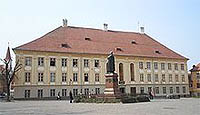 The
municipality is the most important medical centre of the county, hosting
the County Hospital & Academic Emergency Hospital, the Hospital of
Pediatrics, the Military Emergency Hospital and other clinics and hospitals.
It is also a valuable centre of higher education, with several universities,
the most known being the Lucian Blaga University of Sibiu, with 11 departments.
The
municipality is the most important medical centre of the county, hosting
the County Hospital & Academic Emergency Hospital, the Hospital of
Pediatrics, the Military Emergency Hospital and other clinics and hospitals.
It is also a valuable centre of higher education, with several universities,
the most known being the Lucian Blaga University of Sibiu, with 11 departments.
The town`s historical center is one of the
best preserved in Romania, as many elements of the old fortress are
well-conditioned. 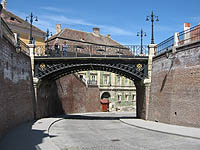 The
city allures with long walks in the Upper and the Lower City, both mirrors
of past times. One can admire the Grand Square, a witness of economic
events of the past and the center of the city since the 16th century,
the Lesser Square, once home of hard-working craftsmen and the Huet
Square, a place of impressive gothic buildings, among which the only
school with German language teaching in the country can be found. A
path that goes from the Upper to the Lower City is the Passage of the
Stairs, that holds a history going back to the 13th century. The picturesque
passage leads to the oldest building in the city, which now is a restaurant.
Another path that links the two sides of the city passes under the Liar`s
Bridge, the first Romanian cast-iron bridge.
The
city allures with long walks in the Upper and the Lower City, both mirrors
of past times. One can admire the Grand Square, a witness of economic
events of the past and the center of the city since the 16th century,
the Lesser Square, once home of hard-working craftsmen and the Huet
Square, a place of impressive gothic buildings, among which the only
school with German language teaching in the country can be found. A
path that goes from the Upper to the Lower City is the Passage of the
Stairs, that holds a history going back to the 13th century. The picturesque
passage leads to the oldest building in the city, which now is a restaurant.
Another path that links the two sides of the city passes under the Liar`s
Bridge, the first Romanian cast-iron bridge.
Defying ages stand the towers that still guard over the city today. The Arquebusiers` Tower, the Potters` Tower and the Carpenters` Tower have lasted since the 15th century, along with the Thick Tower, which was built a century later and hosted the first theatrical representation, in 1778. The oldest towers are the Goldsmiths` and the Council Towers, built in the 13th century. The Council Tower was first used as passage to the fortress, then as a storage place, a temporary prison and even a botanical garden. Its last floor offers a great look-out over the historical city and the Fagaras Mountains.
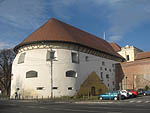 The
beauty of the old city is rounded by the historical buildings. The palaces,
Bruckenthal Palace, ASTRA Palace and Filek Palace are as famous today
as they were in the past. Houses like the Blue House, the Waida House
and the Caryatides House have a charm of their own, together with the
calm of surrounding parks: the ASTRA park, which hosts busts of different
personalities and the Citadel Park. The entire historical centre has
been declared universal monument by UNESCO in 2004.
The
beauty of the old city is rounded by the historical buildings. The palaces,
Bruckenthal Palace, ASTRA Palace and Filek Palace are as famous today
as they were in the past. Houses like the Blue House, the Waida House
and the Caryatides House have a charm of their own, together with the
calm of surrounding parks: the ASTRA park, which hosts busts of different
personalities and the Citadel Park. The entire historical centre has
been declared universal monument by UNESCO in 2004.
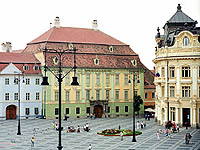 Sibiu
would not be itself without its cultural side, without people giving
life to it. Art devotees can visit theatres (The National Theatre Radu
Stanca, The Kids` and Young Gong Theatre and The Sibiu Ballet Theatre),
can listen to The Sibiu State Philarmonica or can go to the cinema.
The city hosts 8 cultural centres (the Municipal Cultural Centre, the
County Cultural Centre, the Students` Cultural Centre, the Friederich
Teutsch Cultural Centre, the Land Forces Academy Cultural Centre, the
German Cultural Centre, the Ille et Villaine House, the European Centre
of poetry and east-west dialogue) and two associations (the Writers`
Association and the Artists` Association).
Sibiu
would not be itself without its cultural side, without people giving
life to it. Art devotees can visit theatres (The National Theatre Radu
Stanca, The Kids` and Young Gong Theatre and The Sibiu Ballet Theatre),
can listen to The Sibiu State Philarmonica or can go to the cinema.
The city hosts 8 cultural centres (the Municipal Cultural Centre, the
County Cultural Centre, the Students` Cultural Centre, the Friederich
Teutsch Cultural Centre, the Land Forces Academy Cultural Centre, the
German Cultural Centre, the Ille et Villaine House, the European Centre
of poetry and east-west dialogue) and two associations (the Writers`
Association and the Artists` Association).
Sibiu also distinguishes due to its museums, which are organized around two complexes the Brukenthal National Museum and the ASTRA National Museum Complex. The ASTRA Museum of Traditional Popular Civilization in Dumbrava Sibiului is the largest open-air museum in Europe, while the Brukenthal National Museum is the oldest in the country and one of the most beautiful in East Europe. This museum developed from the admired collections of baron Samuel von Brukenthal in the palace with the same same, the Brukenthal Palace. In 1817 the palace turned into a public museum, with collections being permanently well-groomed and enriched. In 1948 the museum was nationalized and other museums were organized in its enclosure. Ten years later the Natural Sciences Museum was included, then the August von Spiess Hunting Museum, the Museum of Pharmacy, the Museum of History and the Contemporary Art Gallery were gradually included as well.
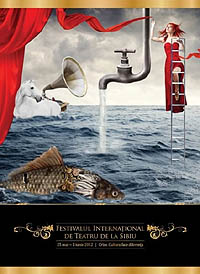 The
old centre of the city is host to permanent and numerous periodical
expositions and fairs. The annual events that attract locals as well
as tourists are the International Theatre Festival (the largest theatre
festival in South-East Europe), the Jazz Festival, the Medieval Art
Festival, the La Strada Unconventional Art Festival and the International
Festival of Electronic Music and Contemporary Art Transylvania Calling.
The most important cultural moment in the history of Sibiu was the year
2007, when the city divided the title European Capital of Culture with
the city of Luxemburg. In honor to its title the city hosted 337 projects
and over 2000 events.
The
old centre of the city is host to permanent and numerous periodical
expositions and fairs. The annual events that attract locals as well
as tourists are the International Theatre Festival (the largest theatre
festival in South-East Europe), the Jazz Festival, the Medieval Art
Festival, the La Strada Unconventional Art Festival and the International
Festival of Electronic Music and Contemporary Art Transylvania Calling.
The most important cultural moment in the history of Sibiu was the year
2007, when the city divided the title European Capital of Culture with
the city of Luxemburg. In honor to its title the city hosted 337 projects
and over 2000 events.
Other annual events are the Geiger MTB Challenge Marathon, a cyclism competition in the mountains that trains both athletes and amateurs and the Sibiu Marathon, the only such event that takes place during night time.
 In
time, religion has always been a valuable harbour for people. In Sibiu,
many churches can be seen today, belonging to the different beliefs
of people who lived here. Among those hard to miss are the Roman-Catholic
Church, the Reformed Church, the Evangelic Church (built in gothic style),
the Metropolitan Cathedral (a reduction print of the Saint Sophia Cathedral
in Constantinopole; since inauguration, it is the cathedral of the Sibiu
Archdiocese and of the Transylvanian Mitropoly), the Din Groapa Church
(one of the first orthodox churches in Sibiu), the Ursuline Church (which
underwent many restorations from its initial gothic arhitecture to the
baroque), the Dintre brazi Church (the oldest church built by the
Romanian Church with Rome in Sibiu; its burial ground holds the graves
of some Transylvanian personalities: George Baritiu, Alexandru Papiu-Ilarian,
Ioan Ratiu, David Urs de Margina, Alexandru Vaida-Voievod etc.) and
the Holy Cross Chapel. The latter homed a massive crucifix carved in
stone in 1417 by the Austrian Peter Lantregen and was also known by
the name The Silver Bell. Situated outside the fortress walls, it
had been invaded several times until it was abandoned and used as shelter
to the sick and the poor, thus given the name The Church of the Sufferers.
The city also has a sinagogue.
In
time, religion has always been a valuable harbour for people. In Sibiu,
many churches can be seen today, belonging to the different beliefs
of people who lived here. Among those hard to miss are the Roman-Catholic
Church, the Reformed Church, the Evangelic Church (built in gothic style),
the Metropolitan Cathedral (a reduction print of the Saint Sophia Cathedral
in Constantinopole; since inauguration, it is the cathedral of the Sibiu
Archdiocese and of the Transylvanian Mitropoly), the Din Groapa Church
(one of the first orthodox churches in Sibiu), the Ursuline Church (which
underwent many restorations from its initial gothic arhitecture to the
baroque), the Dintre brazi Church (the oldest church built by the
Romanian Church with Rome in Sibiu; its burial ground holds the graves
of some Transylvanian personalities: George Baritiu, Alexandru Papiu-Ilarian,
Ioan Ratiu, David Urs de Margina, Alexandru Vaida-Voievod etc.) and
the Holy Cross Chapel. The latter homed a massive crucifix carved in
stone in 1417 by the Austrian Peter Lantregen and was also known by
the name The Silver Bell. Situated outside the fortress walls, it
had been invaded several times until it was abandoned and used as shelter
to the sick and the poor, thus given the name The Church of the Sufferers.
The city also has a sinagogue.
Sibiu and its surroundings are among the most visited places in Romania. The city lays not far from the Fagaras Mountains, which are an important tourist attraction and is also close to the Paltinis resort and the salt lakes in Ocna Sibiului. At aproximatively 100km is the Bâlea Lake, which tourists can visit by driving to the famous Transfagarasan road.
Sibiu is surrounded by Saxon villages, which are known as Marginimea Sibiului. It is an unique ethnographic area in Romania, which enfolds 18 localities and is considered one of the oldest hearths of Romanian ethnogenesis. Existence of man is certified from the middle Paleolithic ages. The main activitiy of people here, a later an austro-hungarian border area, was animal breeding. In search for better grass lands, shepherds often went long distances, across the Danube, toward Constantinopol and across Tisa, toward Poland or the Caucasians, so that a multicultural influence can be felt in those villages.
 An
attraction is the Rasinari village, one of the richest, famous for the
practice of carpentry and sheep breeding. The village hosts an Ethnographic
Museum and every year, in the third Sunday in April it holds a folkloric
festival.
An
attraction is the Rasinari village, one of the richest, famous for the
practice of carpentry and sheep breeding. The village hosts an Ethnographic
Museum and every year, in the third Sunday in April it holds a folkloric
festival.
The Sibiel region is also famous, due to the 200 year old tradition of painting on glass. Tourists can visit the Museum of glass painted Icons, which holds the greatest collection of such icons in Europe (more than 700).
At 10km south is the Cisnadie city, another settlement of Saxons. City evolution is closely related to the evolution of crafts and soon it became known for its scythe makers, saddle-makers, potters and weaver makers. Weaving remained the traditional activity of inhabitants until factories were opened. Evolution of these crafts can be best observed in the Textiles Museum. Another place that cannot be missed is the Fortified Church surrounded by the old fortress walls.
A few kilometers from Cisnadie is the Cisnadioara city, with a citadel that guards from the top of a hill and that resisted against numerous Tatar attacks. A local legend says that the fortress was built with sacrifices and that, in ancient times, a man was not considered worthy of a wife until he carried a big stone from the river to the top of the hill. The city also attracts by its baroque church and a local museum that has a beautiful collection of objects of the Saxon culture.
Another medieval city, 56 km distance from Sibiu is Sebes
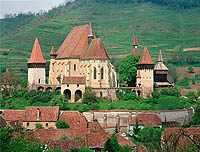 Also,
the area around Sibiu is famous for its fortified churches, which are
UNESCO sites that delight tourists: the Fortified Church in Valea Viilor,
the Fortified Church in Biertan, the Fortified Church in Saschiz and
Fortified Church in Calnic.
Also,
the area around Sibiu is famous for its fortified churches, which are
UNESCO sites that delight tourists: the Fortified Church in Valea Viilor,
the Fortified Church in Biertan, the Fortified Church in Saschiz and
Fortified Church in Calnic.
The rich history of the city, its strongly cultural side, the medieval charm that can still be felt today are enchanting traits of a wonderful, unique town. A simple walk through its streets can take you back in times that are long gone, giving you the experience of a lifetime, one that you would gladly take once again.
 Română
Română English
English